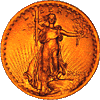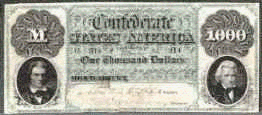Collectors Corner / Coin Collecting
/ Starting a Coin Collection..

 Collectors
Corner
Collectors
Corner 
The Fun of Collecting
United States Coins.
Learn about:
Starting a Coin Collection.
{Where to Find Coins}
{Handling
Your Coins}
{About Cleaning}
{Displaying
& Storing}

Most coin collectors begin with coins of their own country, and the most popular
method of collecting is by date and mint mark. In other words, you will try to find
one coin for each year and from each mint.
Example--- A date and mint-mark
collection of Lincoln cents will include one coin each from the Philadelphia, Denver,
and San Francisco Mints during the years 1909 to the present date. (As of the creation
of this page 1998) You will not be able to find all the mints for all the years.
Some mints produced no coins during certain years.
The easiest and least expensive way to begin collecting coins is to pick them
from circulation. You must do so systematically, however. Otherwise, you will let
too many good coins get away. Every day, put aside any coins you receive in change.
Keep them either in a separate pocket or in a separate spot inside your purse. Do
this with every coin you receive.
Then, in the evening, go through the change,
keeping the coins you don't have. Also compare your day's catch with the coins in
your collection, and exchange the poorer coins in your collection for better ones
from the change. By consistently checking your change every day, you not only add
to your collection, but also upgrade its condition. Upgrading a coin is almost as
much fun as finding it.
Now that you have a collection, you will want somewhere
to keep it--preferably a place where your coins will be protected, yet can be shown
off to other collectors and friends. Suppliers have anticipated your desires, and
there are dozens of inexpensive folders and albums available.
Piggy-Bank
Bank (rolls of change)
Metal Detector
Flea-Market
Auction
Classified
Ad's
Dealers
Always hold coins by the rim. Never pick them up by holding the face and back
between your fingers. The grease you leave on a shiny coin will ruin it. In fact,
it is considered bad manners to pick up another collector's coins other than by the
rim.
Don't drop a coin to test its ring. The nick you may put in it will devalue
it considerably. When inspecting your collection, work over a piece of felt or other
soft material. Be careful with folders; the coin you drop invariably falls onto another
coin, never on the folder itself.
Never, Never, Never..... clean a coin you intend to sell; and never, never
clean a rare coin. Most collectors and dealers refuse to buy cleaned coins, and the
damage you could do to a rare coin is irreparable. However, it is safe to clean some
of the more common coins in your collection.
To clean copper coins, rub them
with vegetable or olive oil and wipe with a soft cloth. Nickel or silver coins are
cleaned by working up a lather in your hands and scrubbing the coin with your fingers.
Rinse off the soapsuds with water, and dry with a soft cloth.
A baking soda.
and water paste will impart a nice shine to silver and nickel coins. However, it
may leave microscopic scratches on them.
Before cleaning any coins in your collection,
experiment on some numismatically useless coins first. Needless to say, never cleans
coins with an eraser or other abrasive; the visible scratches will ruin the coin.
Also, never wash a copper coin with soap and water. The high spots will take on an
undesirable luster. A worn coin that has been cleaned, like a dowager with too much
makeup, only serves to draw attention to itself.
Coin Folders
Folders are the least expensive way for you to display your coins. In fact, so
popular has coin collecting become that you don't even have to go to a coin store
to buy them. They are available everywhere--in drugstores, variety stores, and other
sources not even remotely connected with coin collecting. They cost only $2.99
each, and an entire Lincoln cent collection can be housed in only three folders.
Each folder consists of holes, one for each year and mint. The coins are held in
the holes by the friction around the rim. The date is printed underneath each hole,
and the mintage of the coin is usually shown. When folded shut, no coin can touch
another and scratch it.
The folders have one disadvantage: only one side of the
coin is shown. In a date and mint-mark collection, this is not a serious drawback.
You can turn one of the coins around to show its reverse.
The number of folders
available is amazing. In addition to those for housing today's cents, nickels, dimes,
quarters, half dollars and silver dollars, you will find folders for many obsolete
American coins, as well as for coins from many foreign countries.
Albums
Albums are a more satisfactory way to display a collection because they show
both sides of the coin. Also, the coins are protected by clear plastic on the front and back of each page, which also
holds the coin. (Worn coins have an annoying habit of falling out of the holes of
folders.) These are made by many different company's. ie: Whitman, Dansco, Littleton ect. Most are made to be able to add pages when needed
Because albums cost $20.00-$40.00 each, many collectors keep
coins of greater interest in them and relegate coins of lesser interest to the less
expensive folders.
2"x 2" Holders
Albums are nice: they allow both sides of the coin to be seen, and they don't
take up much room. However, youmay have a collection of medals, tokens, or foreign
coins, and there may be no album suitable for it. Or you may wish to write more information
about the coin than the year and mintage. The cardboard 2 x 2 holders allow you to
tailor your collection to suit yourself. They fold in two and the coin is sandwiched
between acetate or other plastic windows. Costing around three-four cents apiece, the holders
can be bought in packages of 25 or 100. Thus you have the same see-both-sides convenience
of the album, but without the large cash outlay.
Available as a companion accessory
are vinyl pages. Containing 20 pockets, the pages are punched for a standard two-
or three-hole binder. The pages cost .75 cents to $1.00 apiece.
Coins you no
longer want to display can be stored in holders listed below..
Plastic Holders & Tubes
For those who want to go first class, plastic holders are the answer. They cost
from $4.95 (for a holder of one coin!) to $20. or $30. dollars. The best ones consist
of two clear plastic sheets held together by four corner screws. The coins are sandwiched
between the sheets and rest in slight indentions.
There are lower grade 2"x2" plastic holders available for around $ .69 cents each where you place the coin in the center and they snap together and you can see both sides. Tubes are a perfect way to store a large quanity of coins of the same type. Most are hard plastic with a screw cap and are very inexpensive about $ .75 cents each. They will hold the same amount as coin rolls will. Cents (50), Nickels (40), Dimes (50), Quarters (40), Halfs (20) ect. Most of the time if you buy 100 at a time you will get a box with deviders that they are packed in which is great for storing. With a piece of masking tape on top you can write the date of the coins inside and stand them upright in the box. Another type of tube available now is the square tube, made of hard plastic they have a snap down lid and can be stored standing upright or laying on their side in rows. These are a little more expensive maybe $ .85 cents each
but storing makes it worth it. You decide :-)
Storing your Coins
As your collection grows, you will soon run out of albums. You may also acquire
duplicates of some coins. Rather than display ail your coins, you may wish to store
some.
If your coins are in 2 x 2's, they can be kept in special cardboard boxes
which cost around a $2.99 apiece or you get them when you buy the 2x2's by the
100 count.. Also available are Plastic versions for around $5.99 each. Note: If you live near a hardware store sometimes you can purchess plastic storage boxes with 2"x2" openings for small parts, - nuts, screws ect. many different sizes are available where you could hold up to 300 in one box and have them seperated as you wish. These are cheep and can give you the same storage for 2"x2" carboard coin holders. This could save you a little cash :-)
Another way to store your extra coins is glassine envelopes. Capable of holding one coin, they
cost $1.75 per hunderd. They, in turn, are placed into 2"x2" kraft or colored envelopes
which cost 5 or 10 cents apiece, respectively. There is enough space on these envelopes
to write as much data as you would normally desire. The envelopes are then filed
alphabetically and/or chronologically. The different-colored envelopes make it easy
to color-code your collection.
Don't put shiny coins directly into the paper
envelopes. The sulphite in the paper will tarnish them.

Starting a Coin Collection | Types
of Coins (Photographic Journey) | Pocket Goodies "what to look for"
Mint
Marks | Grading | Prices | Coin
Clubs | Collectors Clearing House | Questions
& Answers
News & Note Worthy | Dealer,
Invester & Private Collector Listings | Coin Collecting Software
Glossary of coin collecting terms| Coin Related Links | View Past Guestbooks
Site Map- (listing
of all pages) | Guestbook




- Site Creation & Design by Sleepy 2/14/1998

- 1-1-2003

Disk Works of South Jersey
Copyright © 1997-2003, collectorscorner.org
All Rights Reserved.


 Collectors
Corner
Collectors
Corner 


